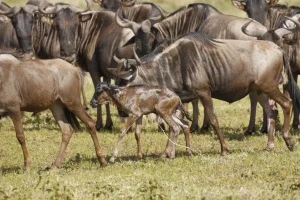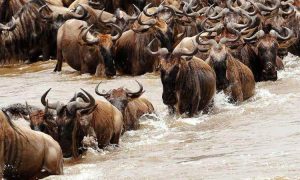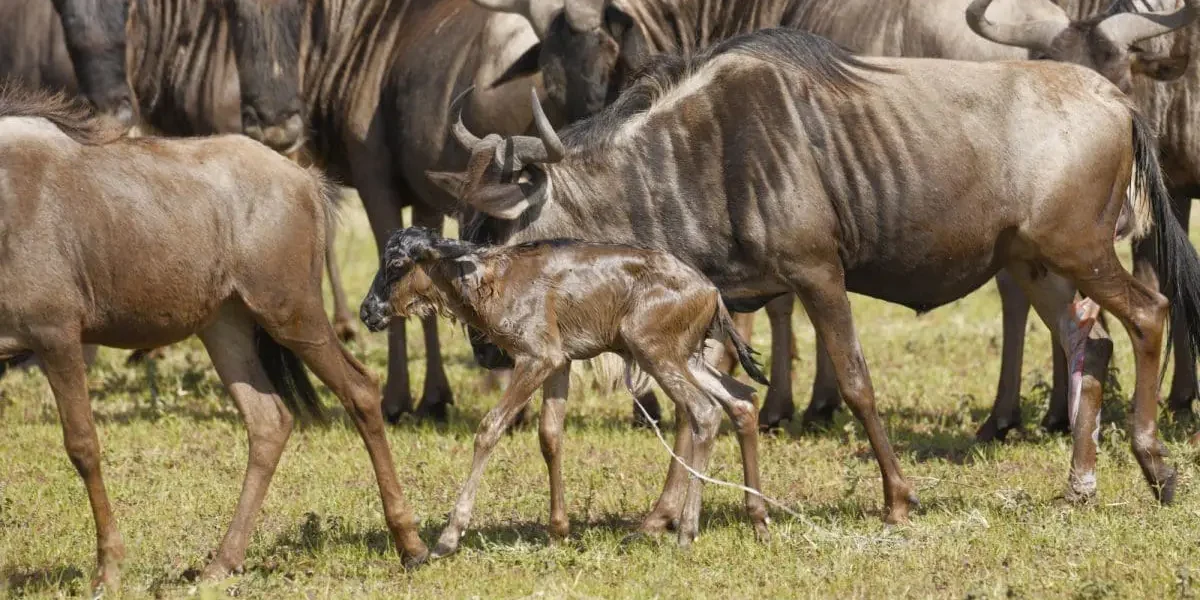Which Month is the Great Wildebeest Migration in Kenya?
Which month is the Great wildebeest migration in Kenya? The Great wildebeest migration in Kenya is one of the most alluring experiences and occurs once a year. The typical great migration into Masai Mara National Reserve often begins in July and runs up to late September. The dates within this period remain unpredictable until these herds of wildebeests converge in the northern parts of Serengeti National Park. During this period, travelers are guaranteed sightings of the great wildebeest migration at the Masai Mara National Reserve.
July-September marks the initial herds and can stay at a spot for a good number of days without crossing the Mara River. Predicting when the exact movement begins is a bit challenging. To guide you when planning your great migration safari to Kenya, we have provided a monthly guide for you to understand how the wildebeest migration event unfolds.

Month-by-Month Travel Guide to Witness the Great Migration
Although most travelers believe that the great wildebeest migration happen once a year, the truth is that the migration is an all-year-round event. Different events unfold as months go by with the river crossing being the most popular of all. This is usually perfectly experienced during the peak season.
It is during the peak safari period of the year when wildebeest move, crossing the Mara River around late July till August then around September, then they start returning to the South in the last 2 weeks of October until early November. Undoubtedly, this is the best month of the year to witness and track the great wildebeest migration in Masai Mara National Reserve.
December – April
Large herds of wildebeest can be spotted around the Southern Serengeti National Park between Ndutu plains and Ngorongoro plains. The great wildebeest migration can be best observed in the southern Serengeti during December, January, March, and April. In February, calving takes place and the speed at which wildebeests move slows down. This makes it the best time for wildebeest migration safaris in Tanzania.
Additionally, spotting epic events in this period is guaranteed. This is when hunters become more active since there are more vulnerable groups. The young and pregnant mother wildebeests become easy targets for hunters. A game drive in Serengeti National Park is a dream come true in such a period. As time goes by, the momentum reshapes and wildebeests move at a normal pace as they approach the central parts of Serengeti (Seronera region).
May to June
It is around this period of the year when the migratory herds of wildebeest tend to move towards the North to look for fresh grazing pasture and water. They move in large columns of about 40 km/25 miles in length as they head to the Central and Western Serengeti. The wildebeests are joined by a huge concentration of zebras, Thompson’s and Grant’s gazelles. The rainy season ends around June and is when the Grumeti River crossing begins but often depends on the level of the water. But the Grumeti River crossing isn’t as powerful as the Mara River crossing.
July, August to September
July to September mark the start of the powerful Mara River crossing. Around these months, the herds are already in the western Serengeti and Grumeti Reserves. In August, those that survive to head towards the North and into the Northern Serengeti then begin their journey to Masai Mara National Reserve.

In the course of the movement, the herd breaks into smaller groups with about half of them staying back in the Northern Serengeti then the rest cross the Mara River. The majority of the wildebeest herds are spotted in the Greater Masai Mara Area as they feed on the lush grass resources before they head towards the private conservancies. The Mara River crossing is notably the most powerful moment to witness.
From October to November
Around October and November, the wildebeest herds migrate towards the South via the Western Loliondo and Lobo areas in Serengeti. The majority of the herds can be spotted in Lamai and Kogatende. November is also when short rains begin and herds can be spotted in the Serengeti as they are stationed in Seronera Valley, Lobo, and Mbuze Mawe. The fresh grazing results in wildebeest clustering in the North-eastern Serengeti and the Southern Serengeti. It is around this period when calving starts again and the predators move in too. The cycle of the migration starts all over again.
The Masai Mara wildebeest migration
The Great Migration is a powerful annual event where millions of wildebeest migrate from Serengeti to Masai Mara in Kenya. The movement occurs each year in the Serengeti-Masai Mara ecosystem. The best months to witness the Great Migration is around mid-July when the migration begins with a huge concentration of wildebeest heading towards the Masai Mara. This spectacular event runs up to August and declines around mid-September.
The population of wildebeest tends to vary each year but revolves around 1.5 million wildebeest, then thousands of zebras and other grazers accompany them. The wildebeest migration often faces challenges, especially when crossing the crocodile-infested Mara River and also Talek River. On crossing, they encounter a significant population of predators.
What is the best time to visit Masai Mara for wildebeest migration?
Mid-July to late August are the best months of the year to visit Masai Mara to observe the great migration. But in terms of months, August is the most suitable month to see the wildebeest migration in the Masai Mara National Reserve in Kenya.
Where do the wildebeest migrate to and from?
The great migration begins from the vast Serengeti plains to Masai Mara National Reserve. The movement is dictated by several factors including pasture, climate, and mating, as well as calving/birthing seasons. But what is most important to have in mind is that this movement occurs throughout the year. It takes a clockwise pattern and mainly takes place around key areas like the Southern, Central, and Western Serengeti then trek for long to the Masai Mara from July to August. The wildebeest begin returning to Serengeti around late October and this is not as powerful as the July-September migration.
How do you see the wildebeest migration?
The best way to witness the powerful Mara migration is by embarking on the guided game drive in the Masai Mara National Reserve. The key area of interest as per the Mara River Migration is recognized as the most powerful annual event.
Where to stay in Masai Mara National Reserve?
Mara Serena Safari Lodge: This is set within the popular Mara Triangle and is stylish in design. It is designed with the circular motif of a traditional Masai Manyatta style depicting the true African natural beauty. The Mara Serena Safari Lodge offers a 5-star accommodation experience and features a myriad of amenities including a bar, restaurants, swimming pool, and others.
Governors’ camp: Located in the lush forest on the winding banks of the scenic Mara River right in the heart of Masai Mara. This luxury facility features comfortable rooms, en-suite bathrooms, a private veranda, a bar, and a range of treatments including facials, body scrubs, massage, and more.
Kichwa Tembo Tented Camp: Set along the Western border of wildlife-rich Masai Mara and is a perfect place for enjoying not only the migration safaris but also other activities like night drives, bush walks, and hot air balloons.














